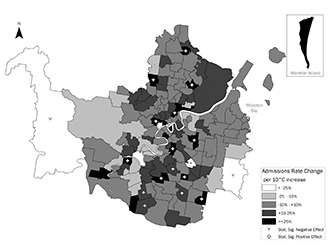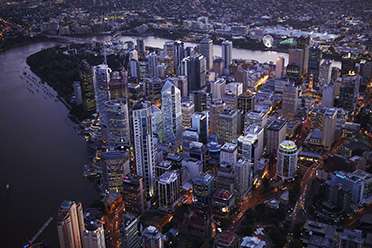These suburbs are hot spots for heat-related illness

Do you live in one of the 16 Brisbane suburbs most likely to land you in hospital in a heatwave?
A research team from QUT and Arizona State University (ASU) studied heat-related hospital admissions for residents in 158 postcodes across Brisbane to map where the greatest heat impacts were.
They found a 10 degree temperature increase in summer was associated with a 7.2 per cent increase in hospital admissions across Brisbane the following day, but hospitalisation figures for 16 of those suburbs were, on average, around 30 per cent.
Archerfield topped the list of hot spots for hospital admissions, followed by Bowen Hills, the city centre's outer rim (away from the river), Deagon and Jindalee.
"Our research shows there are two suburb characteristics that predict a high risk of heat-related hospital admissions - a lack of high-income earners and a higher population density," said QUT Faculty of Health Associate Professor Adrian Barnett, from the Institute for Heath and Biomedical Innovation.
"The link with earnings is most likely because of air conditioning. It's the most effective way of reducing your risk of heat-related illness, but it's a luxury people on lower incomes can't always afford.
"High-density areas tend to get hotter because of the lack of breezes. That's exacerbated by large paved and concreted surface areas, which create a heat-island effect."
The study has been published in Environmental Health Perspectives, a science journal that explores the interrelationships between the environment and human health.

ASU Center for Policy Informatics in the College of Public Programs researcher Dr David Hondula said some of the findings came as a surprise.
"While older people are generally more vulnerable to heat-related hospital admissions, suburbs with particularly high numbers of older residents didn't show as particularly vulnerable," Dr Hondula said.
"Likewise, we didn't find a strong relationship between admissions and suburbs with a high percentage of residents with extremely low incomes.
"This research is important because it can help inform the types of intervention strategies that might be most successful in reducing unwanted health outcomes associated with extreme heat."
The researchers are urging Brisbane authorities to consider geographically-specific interventions to protect residents in vulnerable suburbs and reduce the healthcare burden in periods of extreme heat.
"One solution could be for governments to introduce hot weather payments during extreme heat to encourage vulnerable people to use their air conditioners. The UK uses a similar scheme to encourage people to use heating during extreme cold periods," Professor Barnett said.
"Adopting building practices that reduce the heat island effect, including allowing more green space around buildings, is another option. And incorporating more solar-powered air conditioning could generate much needed cooling while avoiding overloads to the electricity grid on hot days.
"These sorts of targeted initiatives are going to become even more important in the future as we experience more frequent periods of extreme heat."














